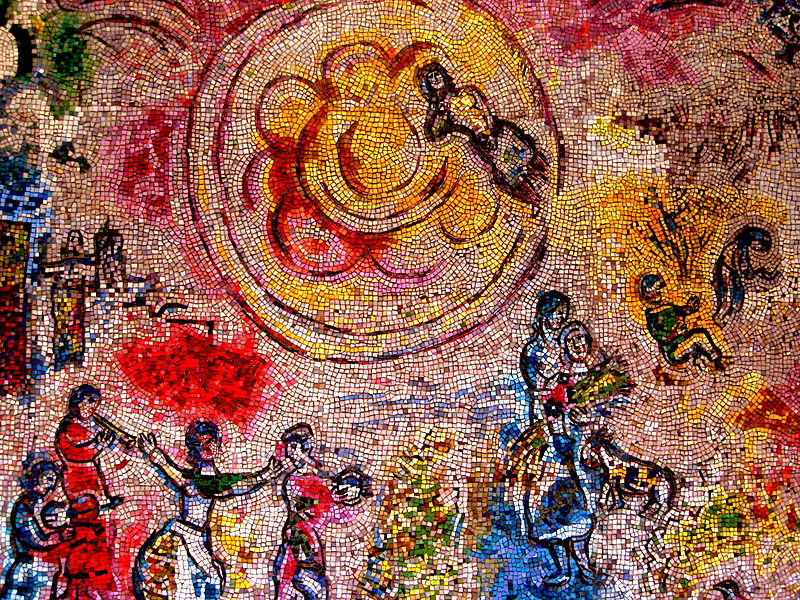
Editor’s Note: This story is one of a monthly series we will be featuring written by directors of CAC Building and Neighborhood tours.
by Susan Jacobson, Class 2008
It’s not Tiffany, and it’s not glass – but it is a highlight of CACs Tiffany Tour. It is Marc Chagall’s Four Seasons, a very different mosaic from those of Tiffany and a masterpiece in its own right.
The mosaic is a monumental work. It spans over 70 feet in length, wrapping around a rectangular support measuring 10 feet wide and rising 14 feet high.
The design of the mosaic was a gift to the city from the artist. He designed the piece in his studio in France, creating 128 separate panels which were then transported and installed in Chicago. The cost of erecting and installing the mosaic was donated by the Prince Charitable Trust.
The mosaic represents an extraordinary technical achievement. There are over 250 colors and thousands of individual hand-chipped fragments of stone, granite, brick, and glass from all over the world.
At the unveiling in 1974 Chagall explained his choice of theme: “I chose the theme of the four seasons because I believe there will be many people going through this plaza in the heart of the city of Chicago. In my mind, the four seasons represent human life, both physical and spiritual, at its different stages. I hope that the people of Chicago will feel the same emotion that I felt when doing this work.”
The mosaic depicts six scenes, stretching around the four sides of the work, thus enticing the viewer to move around the piece to view the mosaic in its entirety. One can see Chagall’s signature in the lower right corner of each of the six scenes.

The design features all manner of different elements — birds, fish, flowers, lovers and suns. In addition to all these images the mosaic displays motifs associated with the city of Chicago, including a Ferris wheel, a cow in a stockyard, and a view of the Chicago skyline. Chagall depicted these using his ‘floating’ figures technique as a way of adding a surreal feel to the scenes. This is a vastly different approach from Tiffany who always sought a naturalistic feel in his work.
Ever the perfectionist, Chagall continued to modify his design after its arrival in Chicago, bringing up to date the areas containing the city’s skyline, which he had last seen 30 years earlier. He also added pieces of native Chicago brick to more accurately depict the color and texture of the city.
Often overlooked in discussing the mosaic is the role of the mosaicist Michel Tharin. He worked with Chagall in his studio, and later oversaw the installation in Chicago.
.Unfortunately, the mosaic was not constructed to withstand the four seasons of Chicago weather, and it deteriorated badly in the years following its installation. As a result, the mosaic was mostly rebuilt in the 1990s and a protective canopy was installed. Boxes of replacement glass pieces were brought in for the restoration project that took more than two years. Some of these pieces are still stored in the basement at Chase Tower!

Now the mosaic is inspected for graffiti and other damage four times a day, cleaned annually and extensively restored every five years. The last full restoration was completed in 2018, with few problems thanks to the canopy and daily inspections.
Guests frequently ask whether there is a design on the top surface of the mosaic. Originally there was. Tharin asked Chagall why there was nothing on top and Chagall told him to go ahead and add a design. Different from the rest of the mosaic, the top featured diagonal and zig zag lines in primary colors of blue, yellow and red. Those who worked in the Chase Bank Building had a clear view of it. But when the mosaic was restored in the 1990’s this design was replaced by simple granite, as the top is now blocked from view by the protective canopy.
_____________________________________________________________________________________________

CLICK HERE for more stories on The Bridge.


It’s fun to show off this piece on the Must-See Chicago tour. Thanks for writing and giving me even more info!
I echo Greg’s sentiment. This is on the Must See tour and I learned a lot from you, Susan. Thanks.
We should give you the title of our Stained Glass Expert.
Thanks, Susan, for a comprehensive & interesting history and description. I miss taking CAC tour takers to see it on the ‘old’ Modern tour and am always happy to have the chance to see it on my own when passing by.
Susan — this always is a favorite stop on the Tiffany tour. It reinforces the Tiffany themes by establishing the contrasts…as you so well explain in your article! Thank you for spotlighting this lively surreal piece of Chicago’s public art.
Thanks for the detailed history! I worked at Chase Tower and enjoyed seeing it every day. It’s a real treasure in the city.
Thank you, Susan! Enjoyed this.
Thanks, Susan, for all the research you did to put this interesting article together!
Adina
Some years ago there was an outdoor cocktail bar right in front of the Chagall—great fun and great Margaritas!